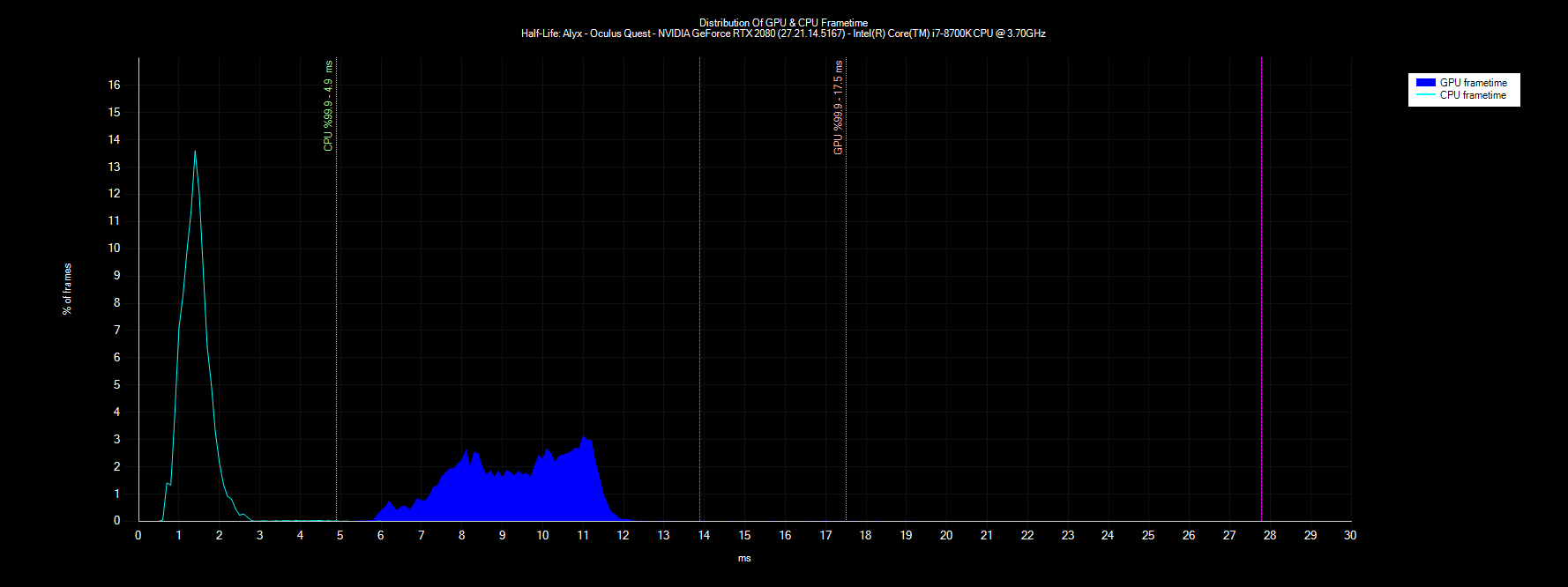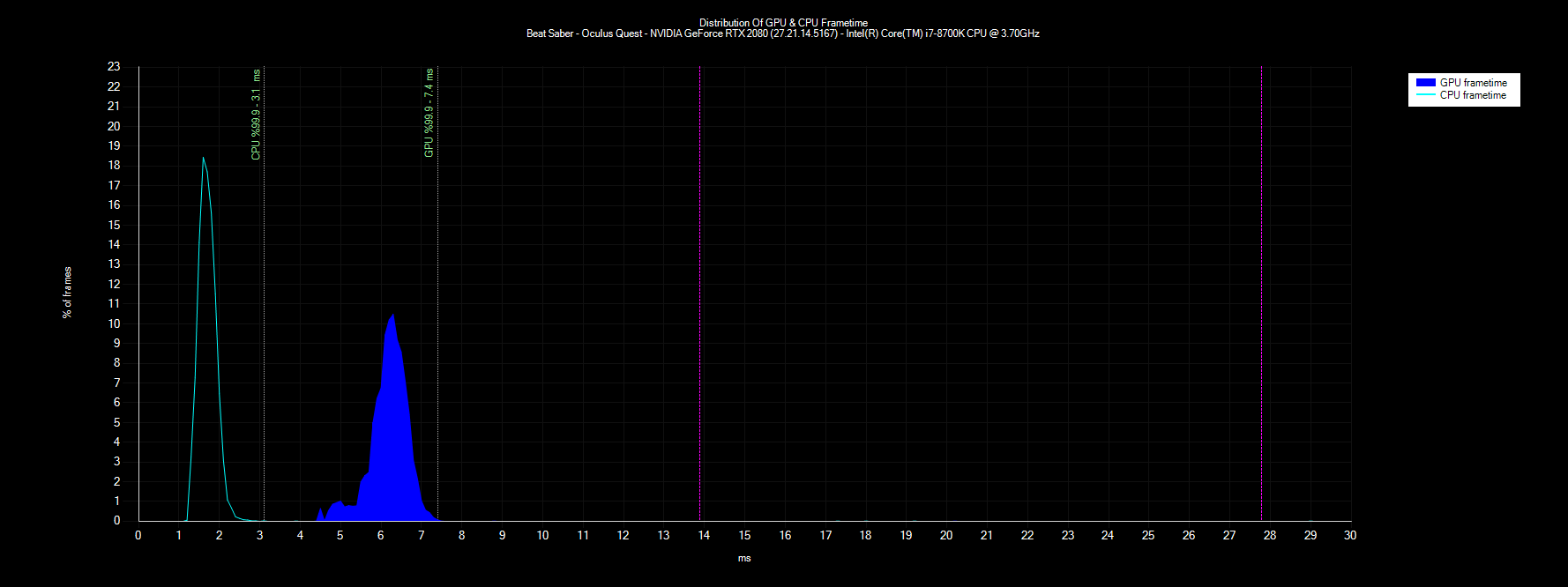Why you can trust Tom's Hardware
We compared the Quest 2 against the outgoing Quest in a small number of games. These tests aimed to determine if the increased resolution has a discernible impact on frame rate and frame time performance.
Oculus Quest 2 Benchmarks and Performance: Test Setup
With the Oculus Quest 2 being a standalone Android device, we don't have a method for testing the headset's default onboard performance; however, we used Oculus Link to capture performance numbers from our PC.
As always, we run our VR tests on a system equipped with an Intel Core i7-8700K at factory clock speeds. The system also includes an Nvidia GeForce RTX 2080 Founders Edition graphics card and 16GB of G.Skill DDR4-3666 RAM.
Half-Life: Alyx
For this game, we had SteamVR's render target set to 150% for both the Quest 2 and Quest. Resolution was at 2880 x 2900 for the Quest 2 and 2528 x 2784 for the original Quest.





Valve's Half-Life: Alyx is a pretty demanding title, so it was very surprising that increasing the resolution by moving from the Quest to Quest 2 didn't make much of a difference on the performance we got from the HMD. The median frametime increased by just over 0.5ms, but 9.5ms is still well below the threshold of a 72 Hz or even 90 Hz display.
When we look at the average frame rate of Half-Life: Alyx, the Quest 2's extra performance needs become more apparent. While the RTX 2080 in our system delivered almost all the frames on time, the average FPS on the Quest 2 fell short of the 72 frames per second (fps) target at 70.11 fps.
Serious Sam VR: The Last Hope
Serious Sam VR: The Last Hope came out in late 2017, but it remains in our testing lineup because it’s still one of the more demanding games that we test. No other test match we run matches the intense action in Serious Sam VR’s endless wave mode. Resolution was at 2880 x 2900 for the Quest and 2528 x 2784 for the Quest.
Get Tom's Hardware's best news and in-depth reviews, straight to your inbox.





The Quest 2's higher resolution compared to the original Quest added 1.3ms to the median frame time in Serious Sam VR. When it came to the 99th percentile, however, we saw huge spikes from the Quest’s 13.4ms to the Quest 2’s 24.2ms. When the frame time gets this hit, you're heavily relying on reprojection software to keep the gameplay smooth. We experienced nearly a 10% loss of on-time frames with the Quest 2.
We ran Serious Sam VR with Steam VR's render target set to 150% for both headsets. It would be easy to reduce the resolution to improve rendering performance if reprojection is an issue for you.
Beat Saber
Beat Saber is one of the most popular, if not the most popular, VR game out there, so it's only natural that we include it in our benchmarks. Beat Saber isn't a very demanding title, so we cranked up the resolution for this one and ran the game at 240% of Steam VR's render target. During our testing, resolution was at 3644 x 3668 for our review subject and 3196 x 3520 for its predecessor.





Our performance results were very favourable across the board when it came to Beat Saber. The report showed 0 missed frames on either headset, with the highest frame time on the Quest 2 coming in at 7.4ms. The additional pixels in the Quest 2 added roughly 0.7ms to the frame time results.
Conclusion
The Oculus Quest 2 is an excellent VR headset. It comes in at a great price, has excellent onboard performance and the option for a more robust gaming experience by tethering it to your PC. In a lot of ways, the second-generation Quest is a big step forward. It's too bad that the overall package is marred by a few steps backwards that hold this headset back from its full potential. Alas, the search for the perfect headset continues.
Still, the Quest 2 has a lot going for it. The lightweight, compact design makes it easier to wear for more extended periods than the first Quest. It's also easier to toss in a bag and take it with you, and the body and the head strap are easy to clean. Key is the powerful XR2 chipset that gives the Quest 2 the horsepower needed to drive incredible experiences at an excellent resolution.
We're also excited to see where the accessories partnerships go from here. New head straps, face cushions and headphones are great, but what else is coming that will strengthen the Quest platform even further?
Quest 2 has some features that some people will disapprove of--specifically, the downgrade of the IPD adjustment system and the lack of a functional Oculus Link cable in the box. And I'm sure I'm not the only person disappointed that you can't use the old controllers.
Overall, the Oculus Quest 2 is a worthy buy for $299 (to start). If you don't have a VR headset yet, this one will undoubtedly tick most of the boxes for you. It's not going to dethrone the Valve Index as the best VR headset for connecting to a PC, but you shouldn't expect it to either. The Quest 2 does what it's meant to do -- provide excellent value for the average VR user -- and it does it well.
The original Oculus Quest was a huge success for Facebook, and the Quest 2 is likely to be even more popular.
- 1
- 2
Current page: Oculus Quest 2 Tested: Benchmarks and Performance
Prev Page Oculus Quest 2 Tested: Specifications and FeaturesKevin Carbotte is a contributing writer for Tom's Hardware who primarily covers VR and AR hardware. He has been writing for us for more than four years.
-
Just Curious These specs look like current generation smartphones, except 1/2 to 1/3 the price. Seems like it should be the other way around.Reply -
jakjawagon Needs information on subpixel layout and FOV.Reply
A quick google suggests it's proper RGB. The Pentile RGBG layout and the upcoming mandatory Facebook integration are my biggest problems with my original Quest, though neither is a dealbreaker. -
Talwyn Wize One incorrect part in your review - the Quest 2 has, unfortunately, the non-5G version of the XR2 chip. I suspect there'll either be a future accessory later, or "Pro" version coming along.Reply
It really would've been awesome to play Rift-style games (AAA-titles) without a cable, though, but there are no doubt still some issues to work out. -
Shadowclash10 See, the funny thing is that if you look at the Pros and Cons, there are just as many Cons as Pros. And TH gave a 4.5 star review, and an Editor's Choice Award (PS. I am not criticizing TH here). I'm pretty sure that if this were any other product category, that many cons, and major ones too, wouldn't fly. But there are such few VR headsets, especially affordable ones, that basically as long as it isn't trash that's unusable , it's fine. Do you see what I mean?Reply -
cryoburner ReplyIPD Setting: 3 mechanical pre-sets (58mm, 633mm, 68mm)
That middle setting should prove useful if you are a hammerhead shark!
Having a mechanical IPD adjustment is good, but there are some rather large gaps between those settings, that will be less than ideal for many. Overall, aside from the improvements to performance and resolution, they made a lot of cuts compared to the original.
Facebook phasing out standalone models is also far from ideal. For someone wanting a PC-connected headset, they will be paying for standalone hardware they might not want, in addition to an expensive $80 link cable.
Plus, Facebook is moving to require users to login to a Facebook account to use any Oculus headset soon. As was expected back when Facebook bought the company, their main goal seems be tracking users in VR, and probably using that data for targeted advertising and selling to third parties down the line. -
Myrmidonas Question from someone who has no experience with VR headsets at all : Suppose I want to play a random non VR first person view game i.e. Conan Exiles, ARK, Elite:Dangerous etc and I want to view the world though the player's eyes with a VR headset, sitting on my desk and still using keyboard and mouse to move and interact. Does this VR headset is enough or is there something else missing?Reply
Any answer is much appreciated. Please point me to the right direction. Thank you. -
gdmaclew Plus, Facebook is moving to require users to login to a Facebook account to use any Oculus headset soonReply
When that happens you can kiss the new headset goodbye. Forcing a customer to create a Facebook account just to use the headset is a non-starter. Facebook better rethink that strategy. -
Playable Replycryoburner said:That middle setting should prove useful if you are a hammerhead shark!
Having a mechanical IPD adjustment is good, but there are some rather large gaps between those settings, that will be less than ideal for many. Overall, aside from the improvements to performance and resolution, they made a lot of cuts compared to the original.
Facebook phasing out standalone models is also far from ideal. For someone wanting a PC-connected headset, they will be paying for standalone hardware they might not want, in addition to an expensive $80 link cable.
Plus, Facebook is moving to require users to login to a Facebook account to use any Oculus headset soon. As was expected back when Facebook bought the company, their main goal seems be tracking users in VR, and probably using that data for targeted advertising and selling to third parties down the line.
I feel like the IPD, controller downgrade, and the forced FB login are deal breakers. I could probably forgive the controllers as I haven't tested them myself but IPD and FB are no go. -
Makaveli Replygdmaclew said:Plus, Facebook is moving to require users to login to a Facebook account to use any Oculus headset soon
When that happens you can kiss the new headset goodbye. Forcing a customer to create a Facebook account just to use the headset is a non-starter. Facebook better rethink that strategy.
They won't this integration was always coming, its why Oculus was purchased. -
husker If Facebook (Oculus) is telling the world that this is their idea of the future of VR, and they are foregoing a VR headset that requires a PC, then it is fair game to compare this headset to any tethered headset. Yes, it is in a different price category, but gamers deserve to get a sense of what they are missing out on if they go with Facebook's vision and become invested into their VR ecosystem.Reply